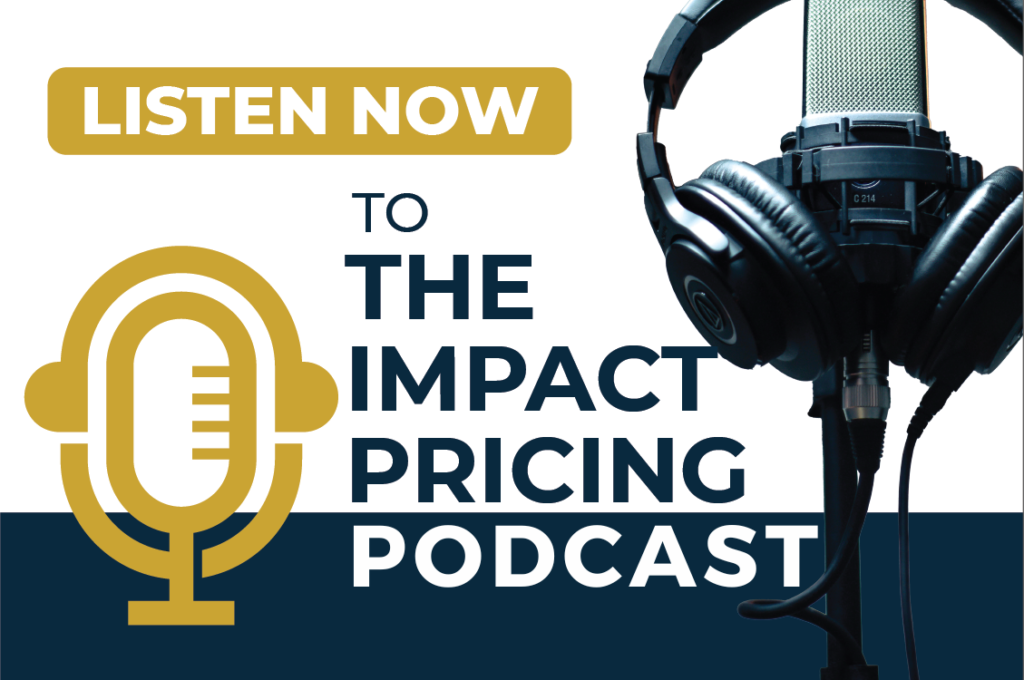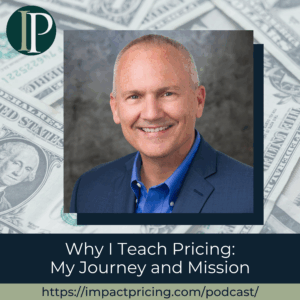Garrick van Buren is the owner and principal consultant at Pricing from the Start, where he helps early-stage entrepreneurs and B2B SaaS companies create effective pricing strategies before they invest heavily in product development.
Since 2003, he has been launching and managing businesses that support entrepreneurial organizations. His diverse experience includes working with creative professionals and agencies, as well as time at a large corporation with established pricing practices. Garrick is also a certified Cicerone (beer sommelier), which gives him a unique insight into customer value and market positioning.
In this episode, Garrick shares his “Pricing from the Start” framework, designed to help entrepreneurs avoid the costly error of building products without fully understanding their value or pricing potential. He emphasizes the importance of qualitative customer research, explains the difference between foundational and detailed problems, and highlights why many entrepreneurs overlook pricing to their own disadvantage.
Alongside Mark, he explores how the Jobs-to-be-Done methodology intersects with traditional pricing strategies, debates various value frameworks, and delves into how to measure value in B2B settings.
Podcast: Play in new window | Download
Why you have to check out today’s podcast:
- Learn how to determine pricing before you build your product, avoiding costly over-investment in questionable features.
- Discover the “Pricing from the Start” framework for early-stage entrepreneurs and established companies at inflection points.
- Understand how to identify foundational vs. detailed customer problems and price accordingly.
“They need to have a price, they need to be comfortable charging it, and they need to approach it in a way that they want it to be repeatable, that it gets at the customer value, and that they can make the decision in an ongoing way of, is there a sustainable business here that we’re developing?”
– Garrick van Buren
Topics Covered:
01:53 – How Garrick transitioned from struggling creative professional to pricing consultant
03:36 – Why entrepreneurs need to know their price before building their product
05:38 – Why successful companies often don’t understand the value they deliver to customers
06:37 – Using MVP and Agile principles to test value through service delivery before building products
08:58 – The “Pricing from the Start” framework: qualitative research and timeless persistent problems
11:57 – Jobs-to-be-Done vs. problem-solution-result-value frameworks: what’s the difference?
15:42 – Foundational problems vs. detailed problems in market segmentation
20:48 – Why the McDonald’s milkshake example may be hurting Jobs-to-be-Done adoption
23:21 – The single sentence framework: “I help [role] at [adjective company] struggling with [timeless persistent problem]”
25:38 – Working with B2B SaaS companies at inflection points and quantifying customer value
28:44 – The 10% rule: capturing value as a percentage of customer incremental profit
Key Takeaways:
“Because the alternative is that they burn hundreds of thousands of dollars on something that they were guessing at and then pushed, shoved, fought, and argued with the developers… because they didn’t do the first few steps.” – Garrick van Buren
“Your competitive set is wider than you think. And that I think really drives how I think about both products, solutions, jobs-to-be-done, pricing, all of those things.” – Garrick van Buren
“If we’re going to capture 10% of value and we’re going to charge $10,000 a year, that means that somebody is expecting $100,000 worth of value in that year against this kind of problem.” – Garrick van Buren
Resources and People Mentioned:
- Pricing from the Start: https://pricingfromthestart.com/
- Jobs-to-be-Done Canvas (referenced in discussion)
- LinkedIn for recruiting (used as foundational problem example)
Connect with Garrick van Buren:
- LinkedIn: https://www.linkedin.com/in/garrickvanburen/
- Website: https://pricingfromthestart.com/
Connect with Mark Stiving:
- LinkedIn: https://www.linkedin.com/in/stiving/
- Email: [email protected]
Full Interview Transcript
(Note: This transcript was created with an AI transcription service. Please forgive any transcription or grammatical errors. We probably sounded better in real life.)
Garrick van Buren
They need to have a price, they need to be comfortable charging it, and they need to approach it in a way that they want it to be repeatable, that it gets at the customer value, and that they can make the decision in an ongoing way of, is there a sustainable business here that we’re developing?
[Intro / Ad]
Mark Stiving
Welcome to Impact Pricing, the podcast where we discuss pricing, value, and the iterative relationship between them. I’m Mark Saving, and I run boot camps to help companies get paid more. Our guest today is Mr. Garrick Van Buren. Yes, there’s a space between Van and Buren. Here are three things you want to know about Garrick before we start.
He is the owner and principal consultant at Pricing from the Start. He’s been starting and running businesses since 2003, all supporting entrepreneurial organizations. And probably the most interesting thing about him is he’s a certified Cicerone, which means he drinks beer. Welcome, Garrick.
Garrick van Buren
Happy to be here, Mark. Thank you for the introduction.
Mark Stiving
It’s going to be fun. How did you get into pricing?
Garrick van Buren
In my early career, I worked with a lot of professional services agencies, a lot of creative professionals. And that was something that we always struggled with is, how do we price our work? How do we price our engagements? And, you know, too often there’s the starving artist stereotype. And I saw too much of that. And I was too much of that.
And then, in 2017, I joined a really large corporation that had a very mature pricing practice in it throughout the organization. And that’s how I was introduced to it as a practice and being able to critically look at it. And so I started blending some of that thinking into how I think about customer research, how I think about product development.
And at the same time was bumping into more and more early stage entrepreneurs that were either completely punting on pricing or didn’t know how to approach it and didn’t know how to craft what pricing might look like before they over-invested into a product.
And I thought, well, I think I can figure this out and I think I can help substantially. And I know the pain of not figuring this out. And now I have some tools that I think I can apply to these problems and really make a substantial impact on their businesses in a short time frame.
Mark Stiving
So do you think most entrepreneurs, or let’s say we’ve just launched a new product or we’re just developing a new product, do you think that they really need to know what price it’s going to be? Or do you think they need to know a ballpark that there’s demand if we charge a price, something like that?
Garrick van Buren
Yeah, they need to have a price, they need to be comfortable charging it, and they need to approach it in a way that they want it to be repeatable, that it gets at the customer value, and that they can make the decision in an ongoing way of, is there a sustainable business here that we’re developing? I think for too long, entrepreneurs have punted on that, and it could be for any number of reasons.
One is that In a lot of the circles that I travel in, there’s for a very long time, a strong bias to go after investment ahead of sales, which can really, really blur who the customer is and who you’re developing for and who has control of which direction the business is going. And the second is I, for some founders, this is the first time they’re even in a sales capacity.
And some of them will cringe at me characterizing it that way, but they are and they need to come to terms with that as quickly as possible. I think that, especially the head founder sometimes, doesn’t realize that what they are really in is a salesperson for a dream and for a vision.
Mark Stiving
Yeah. So first off, I agree with what you just said, but I’m still going to play devil’s advocate for a different reason. So I run into a lot of companies where, in fact, almost every company I run into, they don’t really understand the value of what it is they deliver to their customers.
Garrick van Buren
Yeah.
Mark Stiving
Right.
Garrick van Buren
Yeah.
Mark Stiving
And so, it’s almost like the successful companies, what they did was they built something. They found out that someone wanted to buy it. They figured out, oh, yeah, if we tweak this or add this, you’ll pay me a little bit more. And they kept doing that. but they never really understood what the heck they were doing in terms of the value to the customer.
Garrick van Buren
Absolutely agree.
Mark Stiving
And so, if this is true, how do we expect an entrepreneur before they launch the product to figure out what the value of their product is?
Garrick van Buren
Yes. Because the alternative is that they burn hundreds of thousands of dollars on something that they were guessing at and then pushed, shoved, fought, and argued with the developers, you know, I come from a software context, so that’s who’s fulfilling these things is building these products and overbuilt and questionable value and all of that. Because they didn’t do the first few steps. Because they were, if I could, like, they were so arrogant to say, well, I know the answer here.
Mark Stiving
And in a lot of ways, when you think about Agile and MVPs, this works really well. I mean, that whole theory works really well that says, hey, I don’t really know if there’s value, but let me go build something quickly and see if someone likes it.
Garrick van Buren
Yeah. We’re going to build it for a week or two, and then we’re going to put it in front of customers and say, does this help? I am a huge, huge advocate of that. And because my background is in professional services, I have seen time and time again, the way that you can, customers don’t really care how their problem is solved, especially if they are.
Highly, highly frustrated and really just struggling like any relief, any port in a storm. And so, they don’t care that your product is perfect, just that it helps. And you don’t even need to build a product, but you need to just give them some attention and be the person who is taking ownership of solving that.
And that could be throwing some person at it literally for, I don’t know, two or three weeks, maybe a month, and just say, Hey, Dave is going to help you out. And yeah, we’ll, you know, whatever we charge. this time around.
And then from that, suddenly there’s somebody in your organization, in the entrepreneur organization with direct understanding of how to solve it, all of the constraints and all of the details that now we have enough information to be able to automate, to be able to direct a software engineer to build all of that. And I think without that direct experience, you’re just guessing.
And so, going after delivering the value as a service as the starting point and then sort of tie this back to pricing. I don’t think the pricing changes because the value of solving that problem is persistent for that client organization, however it’s solved. Whether it’s a person or a software or what have you, it’s just a question is which delivery method is going to be most reliable, which delivery method is going to be most consistent, which one is going to be most
Mark Stiving
Approachable or even scalable.
Garrick van Buren
Yeah, right!
Mark Stiving
Okay. So I have two other topics I want to jump to, make sure that we cover this. So the next topic is, talk to me about your framework. So you call it The Pricing From The Start framework.
Garrick van Buren
Yes.
Mark Stiving
And is that what we’ve been talking about? Or is that slightly different than what we’re talking about?
Garrick van Buren
Yeah, it’s what we’re talking about. It’s about. qualitative customer research to understand what it is your customers are trying to achieve and how the problem that you’re helping them address fits into that. To be able to say, oh, you’re trying to get more sales in this way, or you’re trying to cut costs in this way, or you’re trying to increase collaboration between these kinds of stakeholders, whatever that may be.
You’re trying to get more leads, whatever that may be. And I articulate it as there is a persistent timeless problem that your customer is trying to solve. And that problem doesn’t change with technology. How it can be addressed may change with different technologies, but the problem itself is timeless, which means it can be solved in a bunch of different ways and understanding and defining what that is.
And then, once we understand what that is, What that problem is, and as you and I touched on at the beginning, sometimes this is articulated as jobs-to-be-done. What is the job to be done that I am struggling with?
And that then has, in that client organization, there is a window of value that says below which we don’t think this solution can help us, above which it just costs too much and doesn’t make sense for our organization and finding that window. And I think that also stays consistent against the job to be done. The obligation of the vendor is to say, can I deliver a solution that works within that window?
Mark Stiving
Okay. So you brought up the third topic I want to talk about, and that is jobs-to-be-done. And I’m okay if we iterate back and forth and circle around all of these as we go through this conversation. I’ll be totally honest. I have been thinking about pricing in terms of solution, problem, result, and value. So this is in my third book, Selling Value. Solution is your feature. You built a feature to solve a problem.
If somebody has a problem and they use your solution, they get some result, which I think of as a KPI. In B2B, I think of it as a KPI. And if we can move a KPI, that makes money for the company. How much money do we just make for the company? So this is really logical and methodical for me. Yes. And I’ve been thinking this way for a while. I’ve documented it a few years ago. And then, you’ve got this popularity of something called jobs-to-be-done.
And I honestly have not been able to figure out what’s different. Because when someone says to me, oh, this is the job to be done, I can almost always turn around and say, yeah, we solve this problem to achieve this result. And so, I mean, maybe it’s the exact same thing. Maybe it’s different. I want to know.
Garrick van Buren
I see a lot of especially early stage entrepreneurs, but early stages can be later than that as well, who are developing solutions that are very technology forward. and kind of a, hey, look, we can now use this technology to address this problem. Isn’t that clever and neat? And aren’t we all so smart?
But if you compare that technology forward solution against maybe something that is more tried and true, something that has been around a while, the outcome is less with the new fangled solution because it has so many prerequisites. And it’s sort of like, wow, we were able to get a bear to dance. Isn’t that great? Yes, but it’s not pretty. How I think about jobs-to-be-done relative to just solving or defining the problem is that timeless, persistent nature of jobs-to-be-done.
I think there are only a small handful of jobs that businesses have that are persistent and ongoing, and there are a multitude of ways that they can be addressed. And those are jobs-to-be-done, and our solution addresses those in a specific way. I think my resistance to just calling it a problem is the triteness that so often I see in early stage entrepreneurs trying to assert their next big thing.
If we zoom out a little bit with a little bit of perspective, their new thing is much more about the delivery than it is about the outcome. And it becomes less small because all of the prerequisites we need to have in place against articulating that problem. So to me, it’s more about shifting to a persistent timeless. problem definition than just a problem definition.
Mark Stiving
Okay. By the way, I’ve never heard that phrase before. That was really good. I liked it a lot. So one of the things that I think about, I’m in the middle of writing another book, I call it Context-Driven Pricing, and it’s about what’s the context. And to me, when I’m thinking about context, the first thing I care about is what’s the market segment I’m going after.
Garrick van Buren
Yes.
Mark Stiving
And I define those market segments by the problems that we solve. And when I say the problems we solve, I could put your definition of jobs-to-be-done in there, but I call them foundational problems.
Garrick van Buren
Yeah. Okay. Great.
Mark Stiving
There’s a layer of really important problems and then there’s little detailed problems. So, almost every company, think about any feature you put in a product, you put that in because it solved the problem. Now the question is, is that a detailed problem or is that a foundational problem?
Garrick van Buren
Yes.
Mark Stiving
Yeah. So you can jump to one of my favorite companies to talk about is LinkedIn. Not that I know anything about it other than what I can read. But LinkedIn has solved a foundational problem for recruiters to help them find and attain or attract new possible employees, right? So what are some of the detailed problems?
I’ve got to get a whole bunch of different people inside my company to interview the same person, to provide reviews or feedback, so I know this is the right person, right? I need to find people that have the qualifications we really want and, right? I mean, so there’s all these detailed problems we care about, but they’re not the foundational problem.
Garrick van Buren
Right. Yes. Any given product has some gerrymandering of all of those, both the foundation and the detailed problems. We address the foundational one, there’s some gerrymandering of the detailed ones that this particular product addresses, whether it’s because that’s the priority of the development team or that’s what the early stage customer segments were going after and demanded the most, whatever it is, that gerrymandering means every given solution is imperfect.
And that’s the other key component to me about jobs-to-be-done, is the assumption that every possible solution has strengths and weaknesses, has tradeoffs, and which one fits us the best and the gaps in any given solution are the opportunities for innovation. Yep.
Mark Stiving
And so, I think that’s why I don’t like jobs-to-be-done or why it confuses me, because the next layer below market segment, I think of as, I’m going to build a product portfolio. Ok, so if we go back to LinkedIn recruiter, they’ve got good, better, best recruiter packages. So what features did I put in better that I didn’t have in good?
And are those foundational problems that I’m solving or are those because you happen to be a little bit bigger of a company or, you know, you’ve got a different type of corporate architecture. So to me, every one of those, I can go back to the problem, but I have a really hard time with saying, Hey, what’s the job to be done here. Okay. I think that this is fun. I would say it’s fun for our listeners too.
Garrick van Buren
Let’s get really esoteric here. I would say, stick with the LinkedIn recruiter example. Foundational problem, core job to be done is a source of potential employees, a source of qualified employees for a given role. Easy access. And that’s very easy for me to say, timeless, persistent problem.
Whether or not LinkedIn exists, recruiters, companies have this problem. Where am I going to find potential employees? And I would say that if we jump forward to the kind of packaging and tiering that you just described, that packaging and tiering is much more about what is the gerrymandering that is going to fit a given customer segment.
My favorite example is things like single sign-on or HIPAA or any kind of SOC 2 compliance. There is an organizational size below which none of that matters, but above which is integral and you absolutely have to have it. And so it doesn’t belong in the lower tiers at all. And if it doesn’t have a call for a quote with a salesperson in the tier that it has it in, they’re doing it wrong.
Mark Stiving
Yep. So I agree completely. Do you think single sign-on belongs with jobs-to-be-done? Could I use jobs-to-be-done to describe single sign on?
Garrick van Buren
I have a really difficult time, so back up half a second and restart. Floating around in the universe, on the internet, right now is a jobs-to-be-done canvas, jobs canvas. I forget exactly what it’s called. And I’ll tell you, like everybody, like so many, I am a sucker for consolidating a complex concept onto a one pager.
Mark Stiving
Absolutely.
Garrick van Buren
So, I took a look at it and I kicked it around a little bit. And in it, it has this notion of secondary jobs or ancillary jobs or whatever, basically non-foundational problems. And I have a real difficult time with that because I think that It no longer qualifies as a job to be done because it is so much about delivery and so much about a specific fulfillment of a problem or solving a problem in a specific way that I can’t call it timeless and persistent anymore.
And so, therefore, to me, it doesn’t qualify. It becomes more of a, it’s a feature, I guess. Yeah, I’m happy calling those things features that are going to be more or less attractive to different customer segments.
Mark Stiving
I got to tell you, Garrick, I think you’re upsetting every Jobs-to-be-Done person out there right now. I just want you to know that. So now I’m going to ask the classic Jobs-to-be-Done question or example. When McDonald’s created their milkshake, were they sitting there thinking, what’s the classic job? When someone’s driving to work, they want to be able to drink a milkshake, right?
Garrick van Buren
I’m so glad you brought this up. I think one of those problematic things, or one of the things that has hampered adoptions and understanding of jobs-to-be-done has been that example, because I don’t think it articulates clearly. It’s a fun story. It’s an interesting story. It makes you think about the world differently, which is great.
But what does it tell me about jobs-to-be-done? And what does it tell me? How do I repeat that? Not just repeat that story, but apply the learnings of that in other contexts. And I think it does a really poor job of that. What I take from that story is your competitive set is wider than you think.
And that I think really drives how I think about both products, solutions, jobs-to-be-done, pricing, all of those things. Like to think we need to expand our thinking of what kinds of solutions solve this problem, I think it is great. And that’s how you get to really innovative products. And one of which could be a milkshake for breakfast, but
Mark Stiving
So can I say I have never found a situation where I couldn’t describe it in problems and results, but I find lots of situations that I have a really hard time with jobs-to-be-done with.
Garrick van Buren
I am very self-conscious about using the phrase jobs-to-be-done around people that I’m not confident are familiar with it. I think it’s too much lingo in a way that, like you were just saying, problems and results and solutions are not lingo. And I think that’s a good thing.
Mark Stiving
So let me, I’m going to try to defend jobs-to-be-done for a second. Yeah. Just because I’m having, I love this conversation, by the way, absolutely love it. People care about outcomes and what the results are. Yes. And I got to say that as I work with clients and talk to people, probably the single hardest thing for someone to do is to describe the problem that they’re solving.
Garrick van Buren
Yeah.
Mark Stiving
And so, let’s say, for example, that I drink a milkshake every day when I go to work, and I may not be able to say, oh, here’s the problem I was solving. I could just say, hey, I enjoy drinking a milkshake on my way to work, and when I get there, you know, I feel good about it.
So I could describe the outcome better than I could describe the problem. But it turns out, until we can step back and describe the problem, it’s really hard to say, here’s what the optimal solution should be.
Garrick van Buren
So I spent some time inside a corporate accelerator where my role was to find and take and translate the innovative ideas that my coworkers have and turn them into new products, new solutions, bop, bop, bop, bop, bop. And that is where I did my most, the bulk of my jobs-to-be-done work, especially sort of just formative of it. Where it helped me the most is translating a really cool idea into something with a customer outcome.
So much so that when I work with early stage entrepreneurs or any kind of early stage idea, the immediate place that I go, I have got a single sentence now. And I’ll take any idea and I apply it into this sentence just to see, does it hold up? And the sentence is, I help roll at adjective, adjective company, struggling with timeless persistent problems. And so, that reminds us that we’re helping address some problem for a specific person within a specific context.
And that person is looking for some kind of relief or outcome. And so, many times I have talked to a founder and tried to suss out like pieces to fill into that sentence. And I just, I, I don’t know what problem you’re going after. Like it’s neat. And that sounds like fun. And I know you’re delighted by it, but if I flip it around and look at it from the customer’s perspective, I don’t know what I’m getting. And I don’t know what kind of expectations of results to put against this.
Mark Stiving
Yep. Yep. I get that completely. Garrick, this has just been a blast. I love this. I feel like we should somehow turn this back to pricing for a second. So tell me, tell me what you do in terms of helping clients. Who do you typically look for? Who do you typically work for?
Garrick van Buren:
Typically I work for CEOs, CMOs in B2B SaaS companies that are at an inflection point in their organization. Sometimes that inflection point is they’re within a PE, private equity portfolio, and they need to figure out what is willingness to pay? How can we credibly increase overall top line profits?
Sometimes they’re outside of that and suddenly they’re no longer about just how do we maximize fees, but it’s more about how do we really delight customers and how do we find that combination of value that’s going to make enthusiastic advocates and retain those customers. And sometimes I’m talking with an earlier stage saying, okay, we’re going after bigger companies, bigger customers.
How do we get out of our own way and understand how our solution is valuable to this big company in a way that smaller companies with smaller budgets just aren’t able to give us a sense of? And oftentimes I’m sitting in on sales calls with my clients or conducting customer research conversations with my clients to be able to get at the foundational problems, the jobs-to-be-done, where their solution is strong, where it falls down.
And what I love about the B2B context is we can fairly quickly, presuming we’re going after a foundational problem, we can very quickly understand how that problem fits into all of the problems that their clients are trying to solve to make their business successful. And then we can quantify it.
And I think that’s also the one of the missing pieces in so much is that, that quantification of that notion of a value window that I talked about before is across all of the things across the size of this organization. What is this solution worth to them? I like to think in percentages, right? It’s worth 2% of their overall revenues for the year. It’s worth 10% of revenues for the year.
Because I think that starts to also tell us, are we actually going after a meaningful enough problem to these people? And if it’s only, I don’t know, 0.05% of their overall revenues, does it even really matter? Yeah. And that can help us sort of get out of our own way to say, okay, we’re actually going after a foundational problem here for a lot of important, for a lot of substantial businesses and we can really help. Yeah. That’s awesome.
Mark Stiving
One of the things I heard you say, which I love, is the fact that we can quantify value. And I often say in B2B, we measure value by incremental profit. How much more money am I going to make you as a company? And if you can’t do that, you’re actually not adding value to the B2B company.
Garrick van Buren
The example that I share in this, when I first sort of wrapped my head around how to get at quantifying this value, it was a client project similar to that. My client had a solution and their customers, it would increase profitability for them.
And because we were so tied into operationally how those people worked, it was really, really easy to get at just exactly how much more profitable they could be on an annual basis by using this software. And by my calculations, It was exactly 10%, like they were charging exactly 10% of what that overall value was.
And I was like, I don’t know if you guys are doing this consciously, but that is the maximum that I would recommend. Oh, and you’re getting pushback on how high your prices are. Yeah, that doesn’t surprise me.
Let’s find a way to rearticulate or recombine or rebundle to make that more approachable because I would argue that it’s almost not worth it because it’s 10% of what that incremental value is incremental profit is going to be over the year that if it was down to seven or six, it’d be a whole lot more attractive.
Mark Stiving
Yep.
Garrick van Buren
Yeah.
Mark Stiving
I usually recommend, start at 10% or think about 10%. And then if you can reduce risk, as in there’s no risk in this, then you can move up in that number.
Garrick van Buren
Yep. Totally agree. Totally agree.
Mark Stiving
I’ve heard numbers as high as 50%. Please don’t go do that. I’m talking to my listeners. You’ve got to be awesome. Or, if I were selling you a gold bar, guess what? There’s very little risk. I’m not selling it to you at 10% of its value.
Garrick van Buren
Yeah. I sort of think of it as like, five to 10 on cost savings and somewhere five, maybe you can go to 15 if you’re really directly going after a new revenue and it’s clear and obvious how you’re going to help them get new revenue. But I think 10% is just a really good place to start both from a price, but also a segmentation.
If we’re going to capture 10% of value and we’re going to charge, I don’t know, $10,000 a year, that means that somebody is expecting $100,000 worth of value in that year against this kind of problem. Who has the problem so big that they could make another $100,000 off of it and probably plus that. And they’re making at least that already.
So, let’s say they’re an organization that is already making a million dollars a year on this problem. is how I think about it. And so like, okay, well, who are those people and how do I get in front of them?
Mark Stiving
Yep. I think that’s great. Garrett, this has been a fabulous conversation. Thank you so much for your time. If anybody wants to contact you, how can they do that?
Garrick van Buren
I’m on LinkedIn, Garrett van Buren, you can also find me at pricingfromthestart.com.
Mark Stiving
And to our listeners, thank you for your time. If you enjoyed this, would you please leave us a rating and a review? And if you have any questions or comments about the podcast, or if your company wants to get paid more for the value you deliver, email me, mark at impactpricing.com. Now, go make an impact.
[Ad / Outro]
















